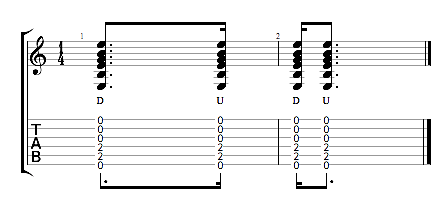Lesson: Strengthening Your Strum

If there’s one thing that I believe we guitarists can really work on, it’s rhythm.
As guitarists we sometimes think in terms of shapes — chord shapes, scale shapes, etc. Many times we learn with fretboard diagrams and tablature, neither of which focuses on rhythm.
And yet our main job as guitarists is to play rhythm. Sure, there might be the occasional opportunity to melt some faces with a solo. But most of the time we’re just chugging away on rhythm.
On top of all that, good rhythm is one of the most important skills to have as a professional musician. Other musicians don’t care what scales or chord shapes you know. They just know if they can groove with you or not. And really, the same goes for your audience.
So let’s check out a few exercises for working on rhythm. In this post, we’ll just focus on strumming.
Strumming the Eighth
The most important thing to remember when strumming is to keep your arm swinging with the beat. In general, you can swing your arm with the quarter-note beat or eighth-note beat, but just keep it swinging, whether you’re hitting the strings or not.
All the latest guitar news, interviews, lessons, reviews, deals and more, direct to your inbox!
In the examples we’ll look at, the strumming arm should swing down with the eighth note.
Exploring the Possibilities
A good place to start developing strumming rhythm is to take a look at the possible rhythms you might run into. If you think of all the different rhythms you could play in a quarter-note beat, there really aren’t that many options.
Leaving out dotted rhythms for now, we end up with these possibilities (using an Em chord):

So that’s five different rhythmic options. Notice the letters “D” and “U” indicating down-strumming and up-strumming respectively.
For practice, first try repeating each measure until it feels comfortable. Once each measure feels good, try mixing and matching. Pick a measure and repeat it four times. Then move on to another measure and repeat it four times. Then another. The idea here is to be able to move to any measure at random, repeating each four times without missing a beat.
When four repetitions becomes comfortable, try bumping it down to three. Then two. And finally just play each measure one time before moving on to another at random, while keeping the metronome going the whole time.
Dotted Rhythms
Just a couple more rhythmic options to toss into the mix, both of which use dotted eighth notes.

For the first rhythm, strum down for the dotted eighth, swing down again without hitting the strings, and then strum up for the last sixteenth note. For the second rhythm, strum down-up, and then swing down again without hitting the strings.
Practice these rhythms along with the five we looked at before, until you can strum any of these seven possible rhythms at random along with a metronome.
There's more to come, so stay tuned!
Ben Rainey works as a guitar teacher and freelance guitarist in the Pittsburgh area. He's also in charge of music content at Tunessence.com.
